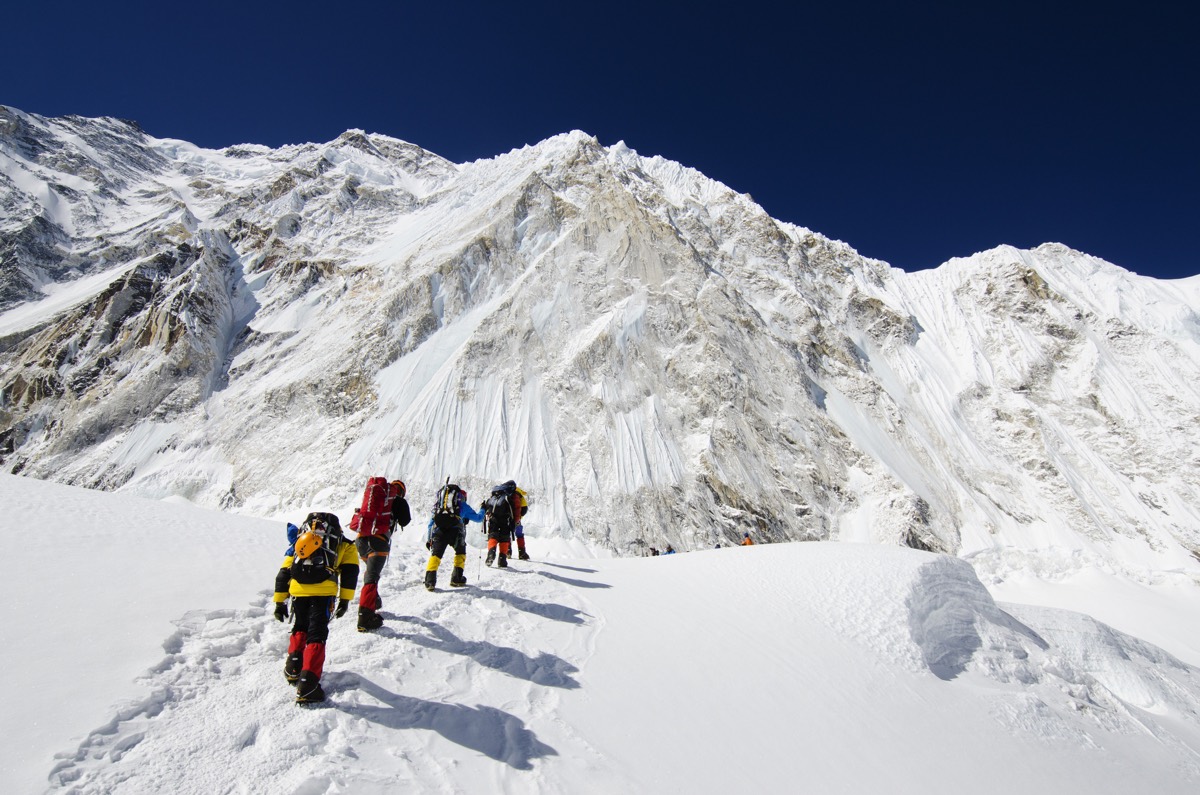Why Are So Many People Dying on Mount Everest?
Massively long lines at Mount Everest's frigid summit — partly due to a few days of good weather — may have contributed to the deaths of seven climbers this week, news sources report.
These crowds led to a deadly traffic jam. One of the mountaineers who died, 27-year-old Nihal Bagwan, of India, was "stuck in the traffic for more than 12 hours and was exhausted," Keshav Paudel, of Peak Promotion, a company that organizes tours on Everest, told Agence France-Presse. "Sherpa guides carried him down to Camp 4, but he breathed his last there."
Exhaustion is a risk that every climber faces. But what is it about Everest's jam-packed peak that's causing some people to lose their lives? [In Photos: Mount Everest Expeditions Then and Now]
Traffic jams mean people will have to spend more time at elevations that are taxing on the human body, and, if they need to descend because of sickness, it's a longer wait to possibly lifesaving treatments, an expert said.
Dangers of Everest
As the world's highest-altitude mountain, Everest stands at 29,029 feet (8,848 meters) above sea level. However, climbers can begin to experience acute mountain sickness at much lower elevations of 8,200 feet (2,500 m), said Dr. Andrew Luks, a professor in the Division of Pulmonary, Critical Care and Sleep Medicine at the University of Washington School of Medicine.

Acute mountain sickness (AMS) isn't fatal, but its symptoms can make a climber feel crummy. AMS affects up to 77% of travelers climbing to heights of between 6,000 and 19,300 feet (1,850 and 5,895 m), Luks wrote in a 2015 study in the Journal of Applied Physiology. Climbers with AMS primarily tend to get headaches but can also experience nausea, vomiting, lethargy and lightheadedness.
"[AMS] is the mildest form of acute mountain illness," Luks told Live Science. It can be prevented if climbers slowly ascend the mountain (after reaching 9,800 feet, or 3,000 m), don't overexert themselves, and take the altitude-sickness medication acetazolamide (trade name Diamox) or the anti-inflammatory steroid dexamethasone, Luks wrote in the study.
Sign up for the Live Science daily newsletter now
Get the world’s most fascinating discoveries delivered straight to your inbox.
A person with AMS should immediately stop their ascent. If symptoms don't improve within a day or two, it's time to go down the mountain, Luks said.
More-serious acute mountain illnesses include high-altitude cerebral edema (HACE), which is a swelling of the brain, and high-altitude pulmonary edema (HAPE), which is a fluid buildup in the lungs. These conditions are rare but can be deadly.
For instance, HACE affects less than 1% of people to climb above 9,800 feet. Many people who develop HACE get AMS first, Luks noted. Once a person's brain swells, they may develop impaired balance or coordination, have an altered mental state, or feel extremely tired. They can even fall into a coma.
People with HACE should descend as soon as possible and, if necessary, be given supplemental oxygen, take the drug dexamethasone or be put in a portable hyperbaric chamber, Luks wrote in the study.
Meanwhile, HAPE affects up to 8% of climbers between 8,200 and 18,000 feet (2,500 and 5500 m). If fluid builds up in the lungs, it can cause the climber to move more slowly and develop a cough, sometimes with pink, frothy sputum.
What's more, frostbite, hypothermia and exhaustion can also wear on a mountaineer's health. And standing in a long line to ascend and descend the mountain doesn't help. [Photos: The World's Tallest Mountains]
Deathly traffic
"The longer someone spends above some threshold elevation at which they might get sick, the greater the risk that they face," Luks said. "And if someone is unable to descend because of a massive line on the mountain, then that is going to make it hard to get them to definitive therapy."
When mountaineers are waiting in line, they're not eating, drinking or sleeping, he said. They're also using up valuable oxygen supplies, if they chose to bring supplemental tanks, and exposing themselves to freezing conditions.
Summit fever, or the drive to reach a mountain's summit no matter what, probably plays a role, too, he said.
"These people quite often, though not always, have invested significant sums of money and time in this endeavor," Luks said. "And on a day when the weather conditions are otherwise good, you can imagine it would be very hard to convince someone to turn around because the line is long."
- 7 Absolutely Horrible Head Infections
- Nepal Earthquake Photos: Odd Effects of Kathmandu Temblor
- See Photos of the World's Tallest Mountains
Originally published on Live Science.

Laura is the archaeology and Life's Little Mysteries editor at Live Science. She also reports on general science, including paleontology. Her work has appeared in The New York Times, Scholastic, Popular Science and Spectrum, a site on autism research. She has won multiple awards from the Society of Professional Journalists and the Washington Newspaper Publishers Association for her reporting at a weekly newspaper near Seattle. Laura holds a bachelor's degree in English literature and psychology from Washington University in St. Louis and a master's degree in science writing from NYU.









